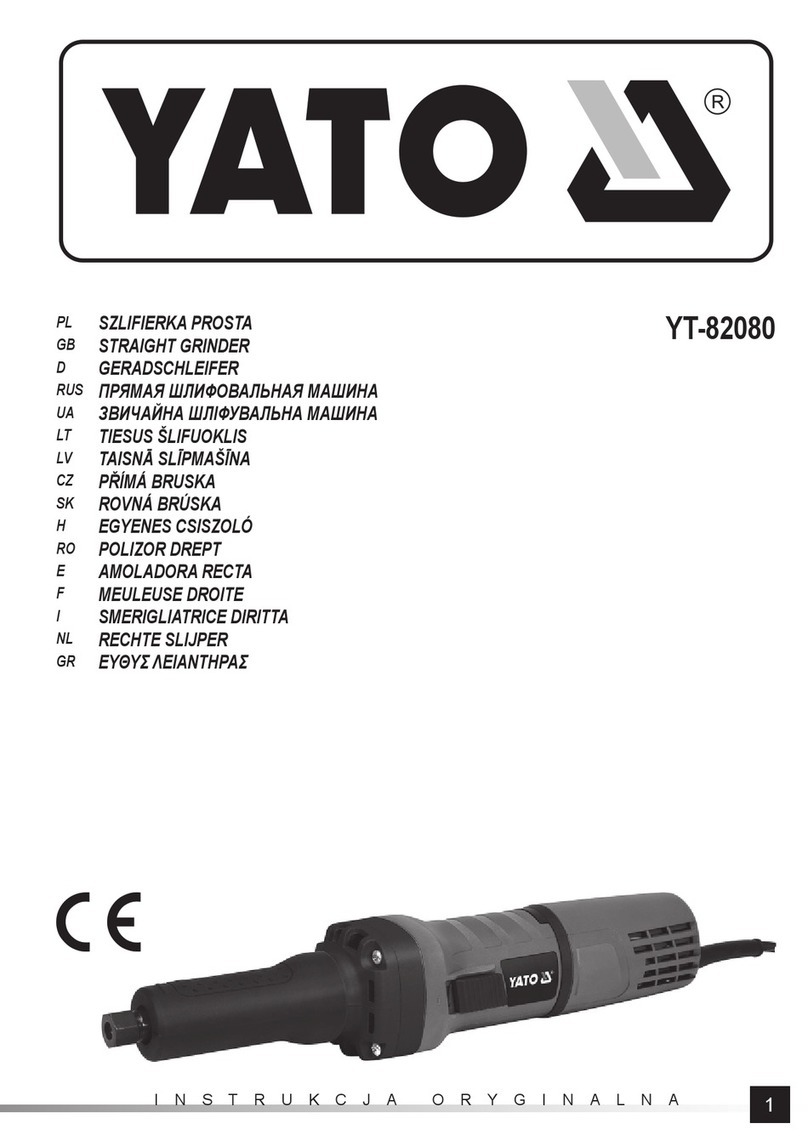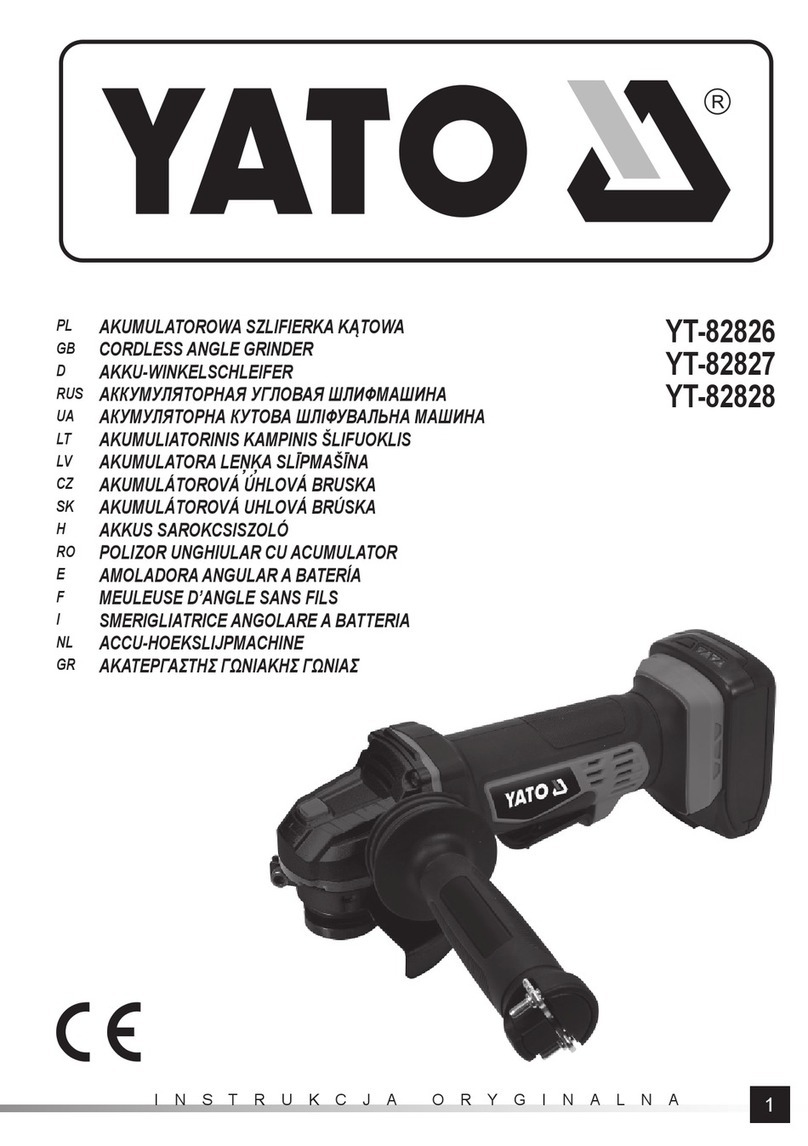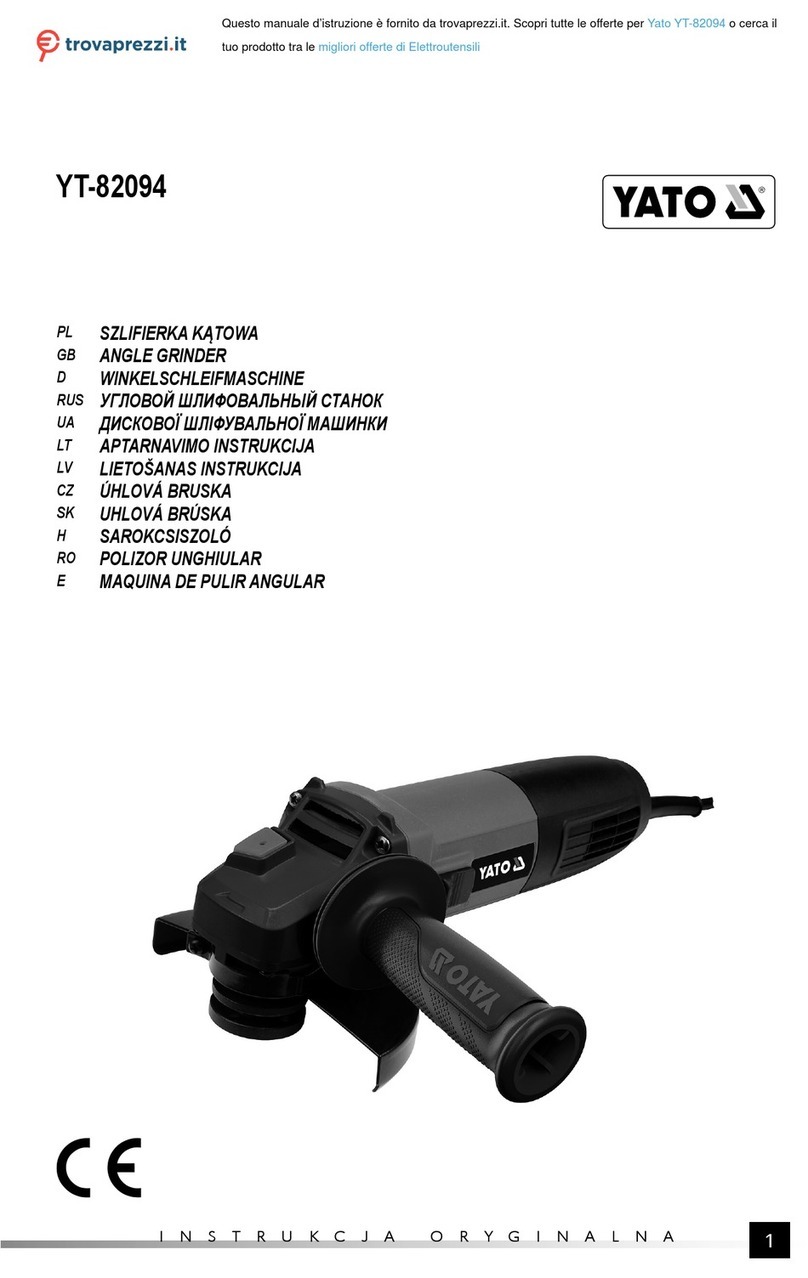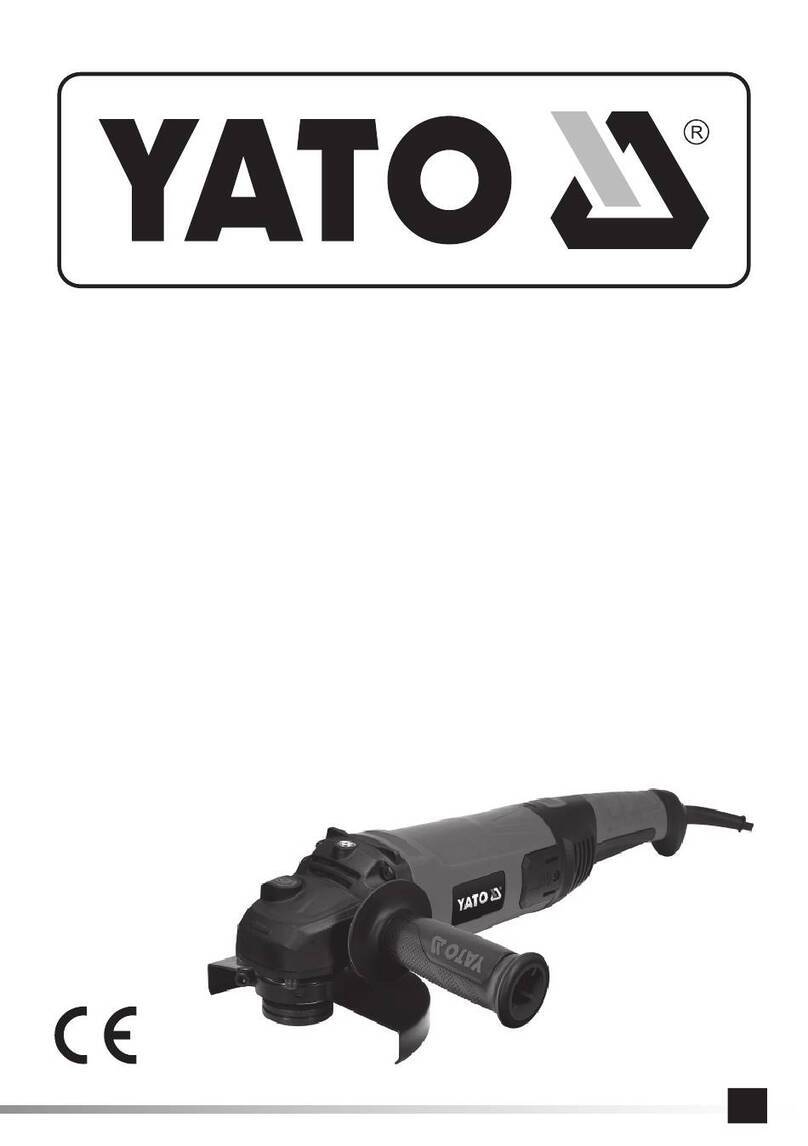
INSTRUKCJA ORYGINALNA
6
PL
Zagrożenia związane z wyrzucanymi częściami
Uszkodzenie obrabianego przedmiotu, akcesoriów lub nawet narzędzia wstawianego może spowodowaćwyrzucenie części z
dużą prędkością. Zawsze należy stosowaćochronęoczu odpornąna uderzenia. Stopieńochrony należy dobieraćw zależności
od wykonywanej pracy. Należy sięupewnić, ze obrabiany przedmiot jest bezpiecznie zamocowany. W przypadku pracy narzę-
dziem nad głową, stosowaćhełm ochronny. Należy równieżbraćpod uwagęryzyko wobec osób postronnych.
Zagrożenia związane z zaplątaniem
Zagrożenie związane z zaplątaniem może spowodowaćzadławienie, oskalpowanie i/ lub skaleczenie w przypadku gdy luźna
odzież, biżuteria, włosy lub rękawice nie sątrzymane z dala od narzędzia lub akcesoriów.
Zagrożenia związane z pracą
Użytkowanie narzędzia może wystawićręce operatora na zagrożenia, takie jak: zmiażdżenie, uderzenie, odcięcie, ścieranie oraz
gorąco. Należy ubieraćwłaściwe rękawice do ochrony rąk. Operator oraz personel konserwujący powinni byćfizycznie zdolni do
poradzenia sobie z ilością, masąoraz mocąnarzędzia. Trzymaćnarzędzie poprawnie. Zachowaćgotowość do przeciwstawienia
sięnormalnym lub niespodziewanym ruchom oraz zachowaćdo dyspozycji zawsze obie ręce. Zachowaćrównowagęoraz za-
pewniające bezpieczeństwo ustawienie stóp. Należy zwolnićnacisk na urządzenie startu i stopu w przypadku przerwy w dostawie
energii zasilającej. Używaćtylko środków smarnych zalecanych przez producenta. Należy stosowaćokulary ochronne, zalecane
jest stosowanie dopasowanych rękawic oraz stroju ochronnego. Sprawdzićtarczępolerskąprzed każdym użytkiem. Nie stosować
tarcz pękniętych lub połamanych, lub tarcz, które zostały upuszczone. Unikaćbezpośredniego kontaktu z poruszającąsiętarczą
polerską, zapobiegnie to zaciśnięciu lub przecięciu rak bądźinnych części ciała. Stosowaćdopasowane rękawice do ochrony
rąk. Nigdy nie uruchamiaćnarzędzia, jeżeli nie zostałzaaplikowany środek ścierny na obrabiany materiał. Podczas pracy na ele-
mentach plastikowych lub nieprzewodzących istnieje ryzyko wyładowania elektrostatycznego. Polerowanie lub szlifowanie może
powodowaćpowstawanie pyłów i oparów, które mogąstworzyćatmosferęzagrożenia wybuchem. Zawsze stosowaćsystemy
pochłaniania lub odprowadzania pyłu, które sąwłaściwe do obrabianego materiału.
Zagrożenia związane z powtarzalnymi ruchami
Podczas stosowania narzędzia pneumatycznego do pracy polegającej na powtarzaniu ruchów, operator jest narażony na do-
świadczenie dyskomfortu dłoni, ramion, barków, szyi lub innych części ciała. W przypadku użytkowania narzędzia pneumatycz-
nego, operator powinien przyjąć komfortowąpostawęzapewniającąwłaściwe ustawienie stóp oraz unikaćdziwnych lub nie
zapewniających równowagi postaw. Operator powinien zmieniaćpostawępodczas długiej pracy, pomoże to uniknąć dyskomfortu
oraz zmęczenia. Jeżeli operator doświadcza symptomów takich jak: trwały lub powtarzający siędyskomfort, ból, pulsujący ból,
mrowienie, drętwienie, pieczenie lub sztywność. Nie powinien ich ignorować, powinien powiedziećo tym pracodawcy i skonsul-
towaćsięz lekarzem.
Zagrożenia związane z akcesoriami
Odłączyćnarzędzie od źródła zasilania przed zmianąnarzędzia wstawionego lub akcesoria.
Unikaćbezpośredniego kontaktu z narzędziem wstawianym podczas oraz po pracy, może byćgorące lub ostre. Stosowaćak-
cesoria i materiały eksploatacyjne tylko w rozmiarach i typach, które sązalecane przez producenta. Nie stosowaćakcesoriów
innego typu lub innego rozmiaru. Nie stosowaćściernic do szlifowania lub cięcia. Sprawdzićczy maksymalna prędkość pracy na-
rzędzia wstawianego (ściernice listkowe, pasy ścierne, dyski z włóknami, tarcze polerskie) jest większa niżprędkość znamionowa
szlifierki lub polerki. Samomocujące dyski polerujące powinny byćmocowane koncentrycznie na tarczy polerskiej.
Zagrożenia związane z miejscem pracy
Poślizgnięcia, potknięcia i upadki sągłównymi przyczynami obrażeń. Wystrzegaćsię, śliskich powierzchni spowodowanych użyt-
kowaniem narzędzia, a także zagrożeńpotknięciem spowodowanym instalacjąpowietrzną. Postępowaćostrożnie w nieznanym
otoczeniu. Mogąistniećukryte zagrożenia, takie jak elektryczność lub inne linii użytkowe. Narzędzie pneumatyczne nie jest
przeznaczone do stosowania w strefach zagrożonych wybuchem i nie jest izolowane od kontaktu z energiąelektryczną. Upewnić
się, że nie istniejążadne przewody elektryczne, rury gazowe, itp., które mogąpowodowaćzagrożenie w przypadku uszkodzenia
przy użyciu narzędzia.
Zagrożenia związane z oparami i pyłami
Pyłi opary powstałe przy użyciu narzędzia pneumatycznego mogąspowodowaćzły stan zdrowia (na przykład raka, wady wro-
dzone, astma i/ lub zapalenie skóry), niezbędne są: ocena ryzyka i wdrożenie odpowiednich środków kontroli w odniesieniu do
tych zagrożeń. Ocena ryzyka powinna zawieraćwpływ pyłu utworzonego przy użyciu narzędzia i możliwość wzburzenia istnieją-
cego pyłu. Obsługęi konserwacjęnarzędzia pneumatycznego należy przeprowadzaćwedług zaleceńinstrukcji obsługi, pozwoli
zminimalizowaćemisjęoparów i pyłu. Wylot powietrza należy tak kierować, aby zminimalizowaćwzbudzanie pyłu w zakurzonym
środowisku. Tam gdzie powstająpyłlub opary, priorytetem powinna byćkontrola ich w źródle emisji. Wszystkie zintegrowane
funkcje i wyposażenie do zbierania, ekstrakcji lub zmniejszenia pyłu lub dymu powinny byćprawidłowo użytkowane i utrzymy-
wane zgodnie z zaleceniami producenta. Wybierać, konserwowaći wymieniaćnarzędzia wstawiane według zaleceńinstrukcji,
aby zapobiec wzrostowi oparów i pyłu. Używaćochrony dróg oddechowych, zgodnie z instrukcjami pracodawcy oraz zgodnie z
wymogami higieny i bezpieczeństwa.















































